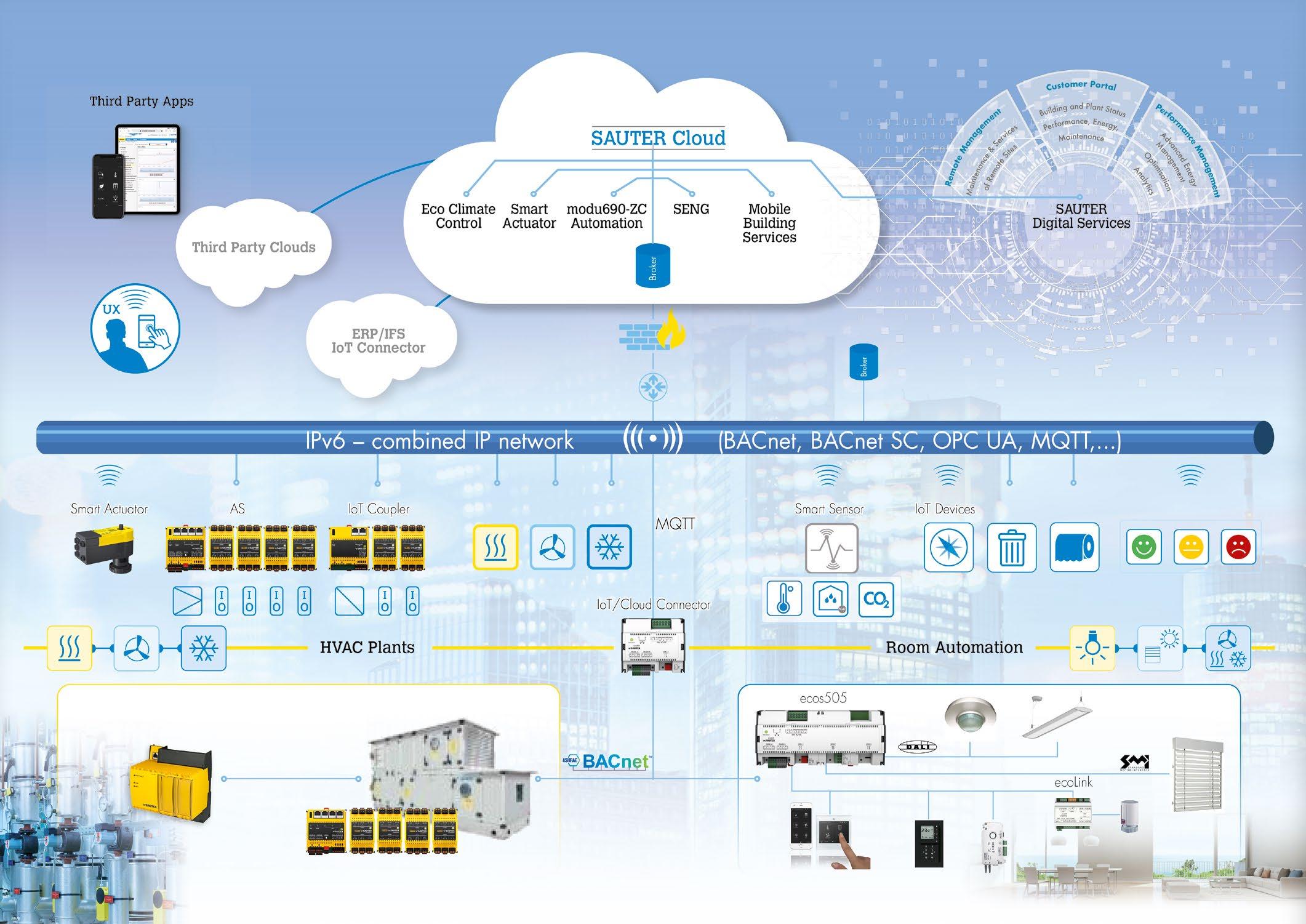
5 minute read
SAUTER Digital Services
The focus of the corporate world has, for years, been on digitalisation like no other megatrend. At SAUTER, this is no exception. The subject dominates all areas of the company, opening up new fields of activity time and again. As we become a digitalised company, we would like to give you regular updates about new projects and how our customers stand to gain from them. With our familiar topologies, SAUTER Cloud Services have floated over all our products and solutions for quite a while now – at least visually anyway. It’s time we shed some light on this.
Getting to the crux of the matter
Before “cloud computing” existed, companies had to purchase their own servers, storage and network hardware. In addition came installation of operating systems and software, even individual applications. This was not only expensive, it also required a fair deal of maintenance – not to mention the risks involved with regular updates (both performed and missed). This is just looking at the customer aspect however. Software vendors faced the issue of not all customers being up to date. This meant that vendors constantly wasted time trying to get outdated software to work with new operating systems. They could have devoted their entire resources to developing new functions and versions instead. Our own industry had its challenge of high investment costs. This prevented operators of small and mid-sized buildings from using powerful management levels with bespoke performance reporting. With information lacking, energy-efficient operation of buildings was not possible.
Enter “cloud computing”. The emergence of clouds has sparked the reinvention of providing software and storage space – even computing power – as a service. Everything happens over the internet. The modern building operator logs in to the cloud portal via the internet, gaining immediate access to the whole building technology, visualisation of processes and an analysis of process performance. The financial world refers to a shift in capital expenditure from investment proceedings – affecting physical assets and therefore rather rigid and expensive – to more flexible investments and investment processes. In other words, the shift from “CapEx” to “OpEx”.
In the macrocosm of cloud computing, an entire ecosystem of software companies now exists. They offer specific subscription-based applications obtainable on the web – "Software as a Service", or SaaS. The corona crisis has given an extra boost to this SaaS sector.
Advantages of SaaS
• Subscription-based access to the latest software versions
• Updates are performed behind the scenes, with no customer input required
• The service is hosted on the provider’s server (either proprietary or leased)
• Access is via the internet, i.e. the service is used similarly to standard email or streaming platforms
• Potential reduction in costs, if fixed costs can be spread amongst users
• No major investments necessary. Computing-intensive functions (e.g. analytics) are also available for small and medium-sized buildings
Self-optimisation: the next logical step
More and more companies are thus switching to the cloud and conducting their business online. This creates new commercial opportunities for building automation too. We see how building automation demands ever greater processing power, larger data volumes, and yet, easier operability. The facility is also meant to embed seamlessly in the Internet of Things (IoT), which already interconnects equipment systems and people. Our Smart Spaces demonstration area impressively shows how this can look within buildings.
We therefore have unprecedented computing power from the cloud providers on the one hand. On the other, there is a flood of data or parameters, all measured by numerous devices. Nowadays, analytical programs – coupled with artificial intelligence – not only produce statistical evaluations, turning data into digestible and useful knowledge. They also have the ability to control a plant with foresight. We are moving beyond the development of intelligent buildings and entering the realm of self-optimising ones instead.
In product innovations such as modulo 6 and the Smart Actuator, SAUTER has already created hardware attuned to the potential of cloud computing. Even now, smart equipment integrated in IoT can make action recommendations. And our goal is an all-encompassing digital encounter for our customers.

SAUTER Cloud Topology, 2020
The new customer experience – software from the cloud
Customer Portal
The building manager logs in to the customer portal by means of a single ID. Here they can access both building installations and software solutions – from engineering to plant control. The manager can call up all plant documents, contracts and invoices. Exporting reports and defining maintenance cycles is also possible. To contact servicing staff, or SAUTER itself, he or she just needs to press the right buttons.
Clear symbols provide an overview of the installation statuses. The manager will find a higher consolidation level in the performance management area.
Performance Management
This is where current and historical data are combined. Scalable computing and storage options provided by cloud computing and advanced analytics can evaluate information currently stored on local servers. This is then used to optimise installations. Even the smallest unplanned component behaviour is considered; the vibration of ventilation dampers or valves, for example. In this case, their constant opening and closing would strain the mechanics, thus drastically shortening their life cycle. Preserving and maintaining hardware, and saving energy and resources, are the key objectives. This consolidated information permits anticipatory optimisation of plants – "prophylactic treatment", to use the medical jargon.
Energy management in the cloud also offers unprecedented options while providing tailor-made reports automatically for customers. Our clientèle will soon be able to see what Advanced Energy Management is capable of with SAUTER Vision Center 7; a forthcoming solution as part of our cloud services.
Remote Management
The need for off-site installation control increases as building numbers rise and the distance between properties becomes greater. This is not a new necessity, although it has certainly come to the fore in recent months during lockdown. What we deliver with remote management is a completely transparent “site-to-site” connection between SAUTER – or the service technician – and the customer plant. Our remote management solution provides a cloud interface between the customer plant and service technician. The connection fulfils today’s cyber security requirements and defines specific user rights and roles.
From a technical aspect, remote management is completely flexible and can access hardware, software and the network. We deploy our engineering tools via the remote management cloud as if on-site at the customer installation. The cloud acts as a relay station, receiving signals and forwarding them automatically. What is more, a standardised internet connection avoids lengthy, cost-intensive and customer-specific configurations.










